
Seljuks went ahead and even split to two branches after they entered Anatolia because of succession.
You're such a treasure trove! Bless!

Seljuks went ahead and even split to two branches after they entered Anatolia because of succession.


I only wish that they wouldn't waste so much development time on gimmicky 3D art. Especially in the case of the whole court system since it's tied to the DLC ergo we won't probably see new court styles beyond the four ones that are coming with it.Yeah, as of now it seems that Royal Court is designed to serve as a basis for further, more in-depth content. It’s a really big, fundamental redesign of many gameplay aspects when you take a closer look, it definitely can serve as a starting point for things to come. That’s why it’s in development for such a long fucking time.
I only wish that they wouldn't waste so much development time on gimmicky 3D art. Especially in the case of the whole court system since it's tied to the DLC ergo we won't probably see new court styles beyond the four ones that are coming with it.Yeah, as of now it seems that Royal Court is designed to serve as a basis for further, more in-depth content. It’s a really big, fundamental redesign of many gameplay aspects when you take a closer look, it definitely can serve as a starting point for things to come. That’s why it’s in development for such a long fucking time.
Also, if you look at the images of the court from the latest dev diary (comparing low vs max splendor for the Polish court), it doesn't look impressive at all regardless of the level of splendor.
I think its interesting Paradox is focusing on a relatively big expansion rather than the older, smaller DLC.
Could the reign of the old DLC model be ending? I suspect they might be more interested in continuous revenue sources now, you know, stuff like Gamepass and such.
That's already there by default.More like, the only brother to escape getting purged ends up in rebellion against you.
Dev Diary #82: Court Type Content
NEWS PC / 2021-11-16

Howdy, y’all!
Once again shadow posting for our wonderful Dev, CC! Who could this mysterious figure be who I am ghostwriting for? We may never know the answer to that. However, we do know that the info from today will be quite interesting for those of you following along with Royal Court updates and information!
Without further ado, may I present:
Hello and welcome to another Dev Diary. We talked about the Court Types system last week, and continuing on that, this week we’ll showcase the different types of content you might experience depending on your chosen court type.
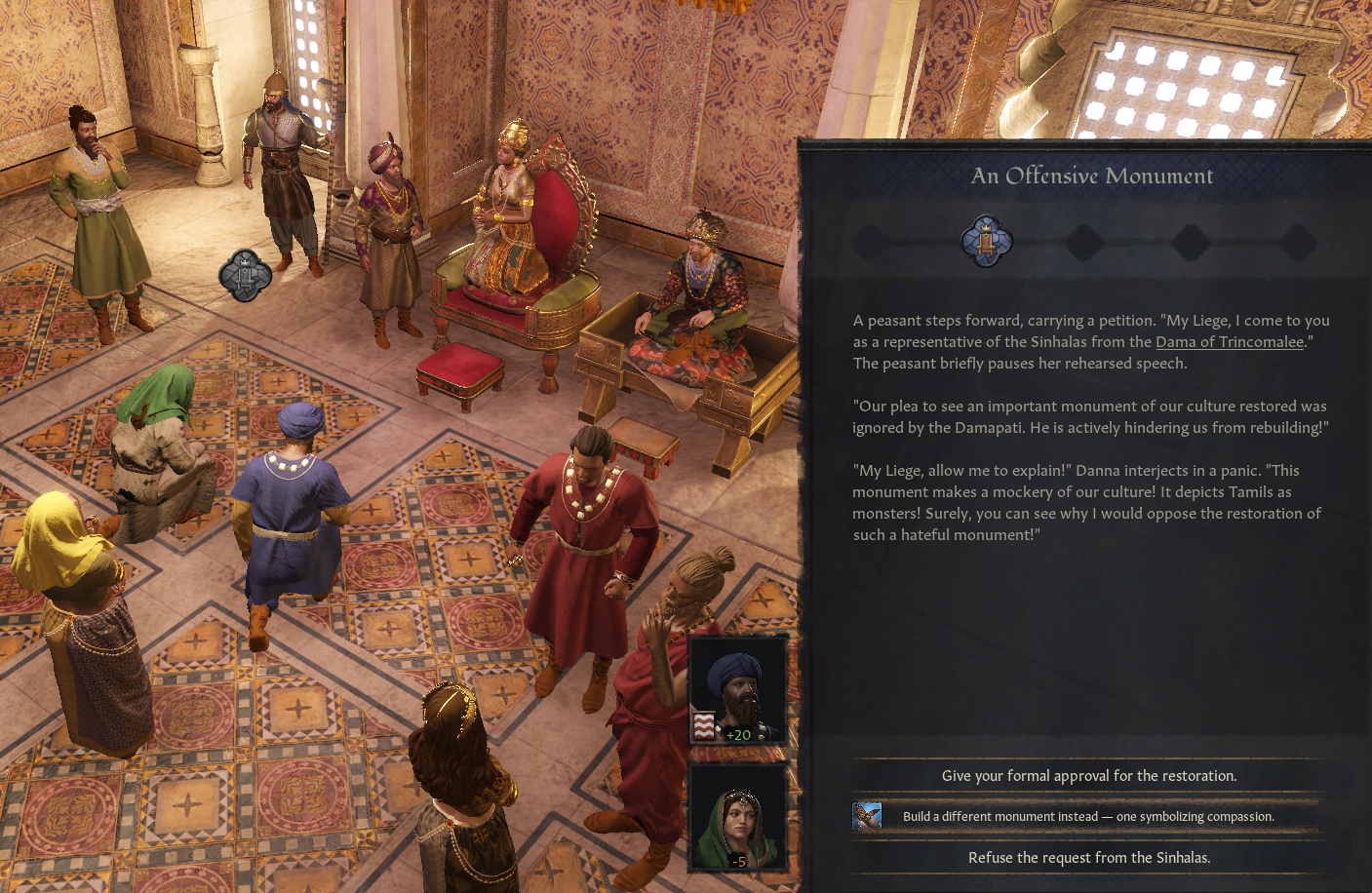
[image showing a petition court event about an offensive monument; more common in diplomatic or administrative courts]
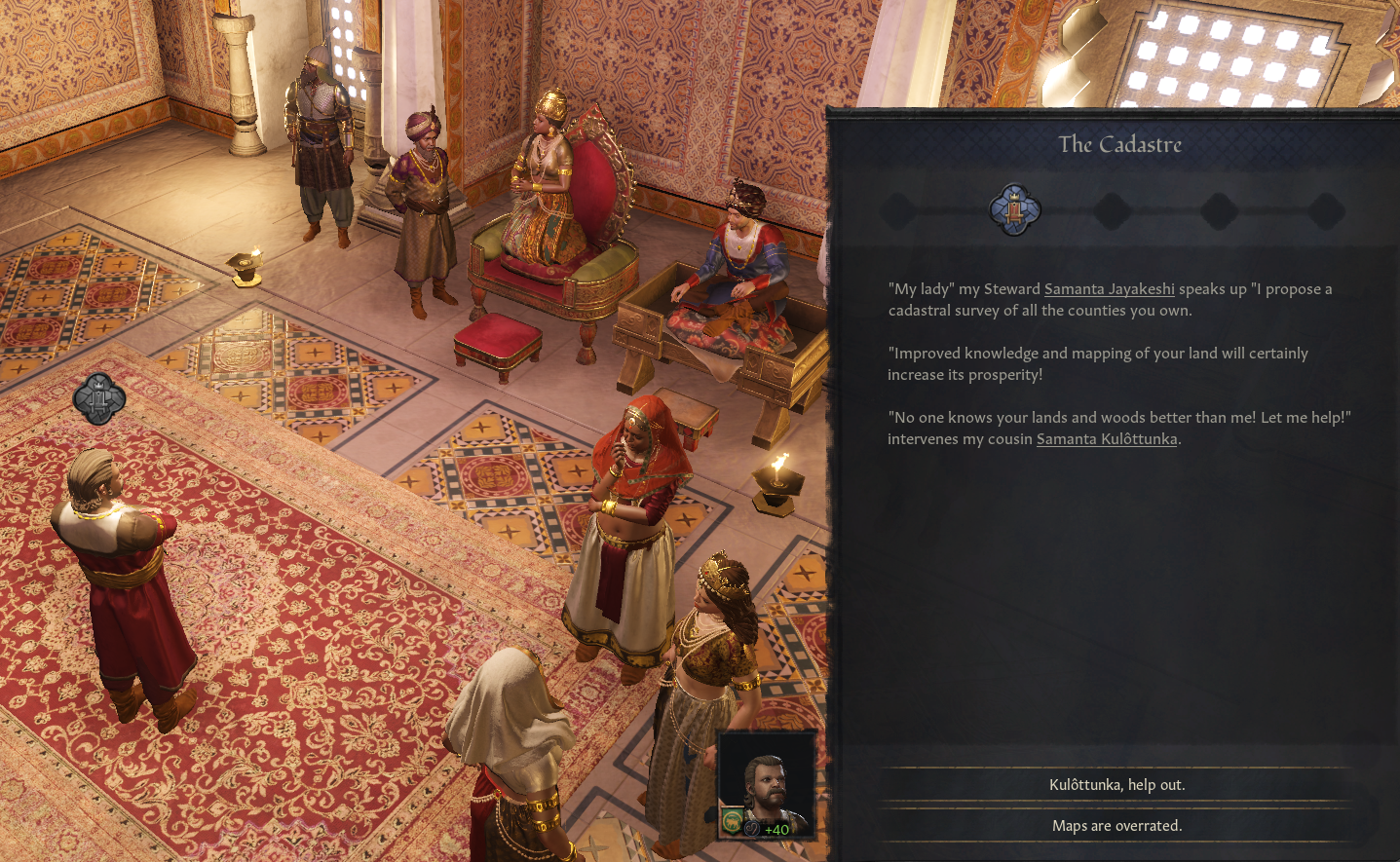
[image showing a petition court event about funding a cadastre; more common in administrative courts]
If your court is known as a place of learning, then you can expect events concerning scholarly matters to be more common. If it’s a place famed for its administrative nature, then events related to that will be more frequent.
These “court event weighings” don’t eliminate events from the pool, they just alter their “weights.” It’s not just petition events that are affected either, but the court events too.
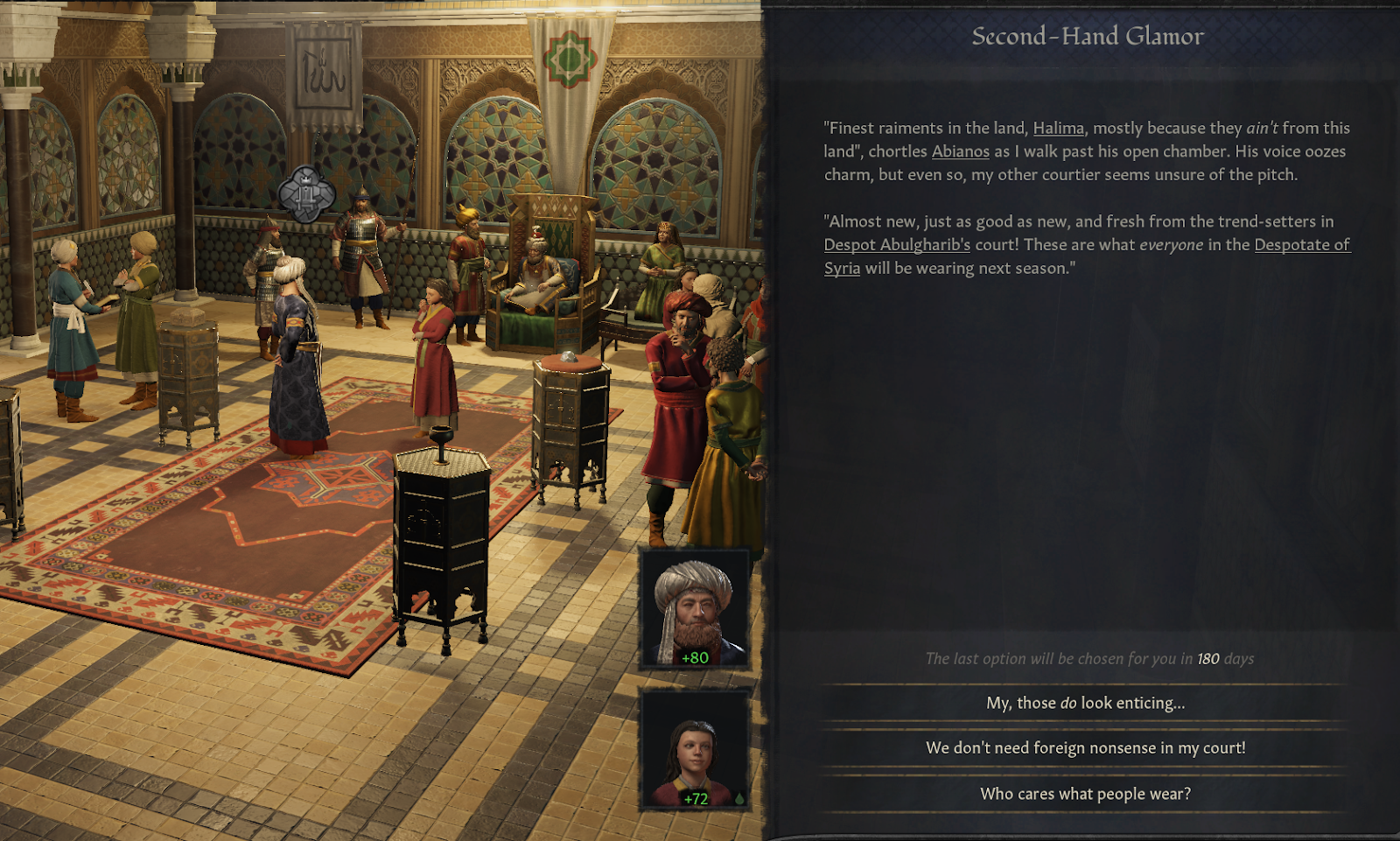
[image showing court event about reselling a neighbouring country’s fashion; more common in diplomatic courts]
And if you think that the events are limited to the court room alone, nay nay. We’ve added court type weighted events outside of court as well. Nothing is sacred, nowhere is safe.
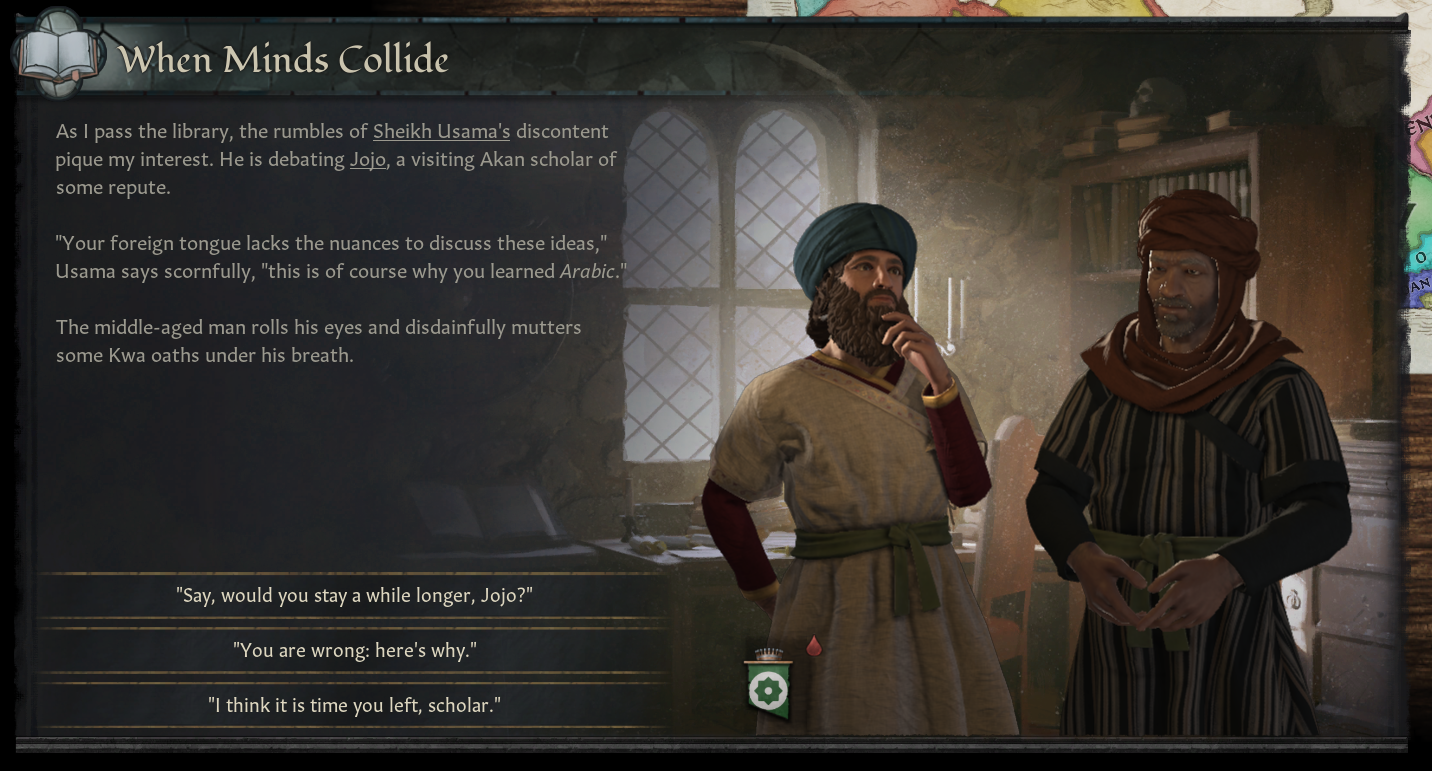
[image of event where an academic disagreement is happening; more common in scholarly courts]
Likewise, some new content is based off of your grandeur level and even your amenities. For instance, if your lodgings are low enough that you’re struggling to house everyone, that does give a _rather_ convenient excuse to evict guests and other scroungers from a cramped castle.
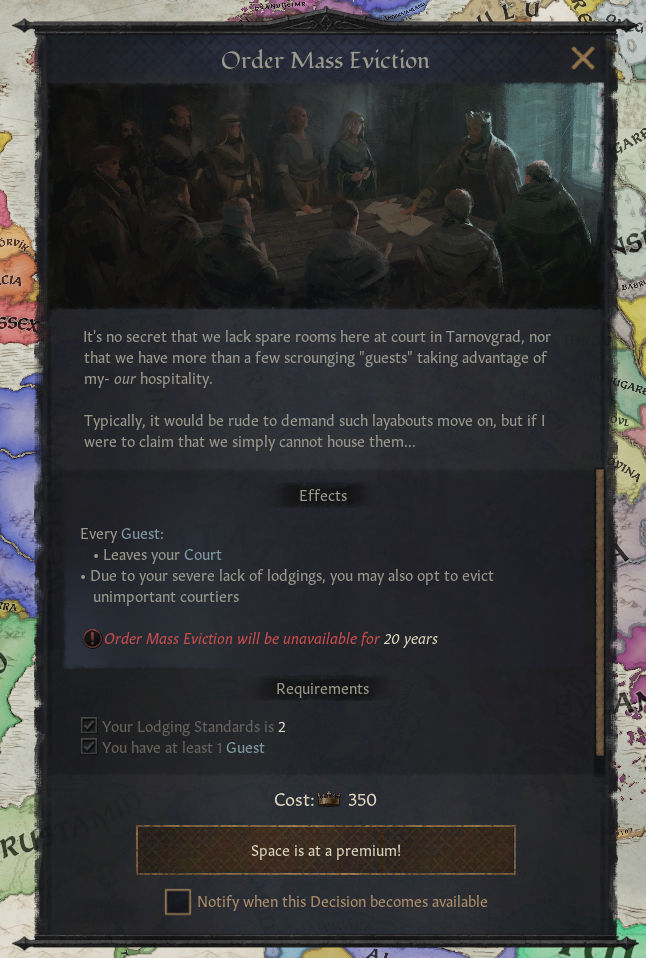
[order mass eviction decision]
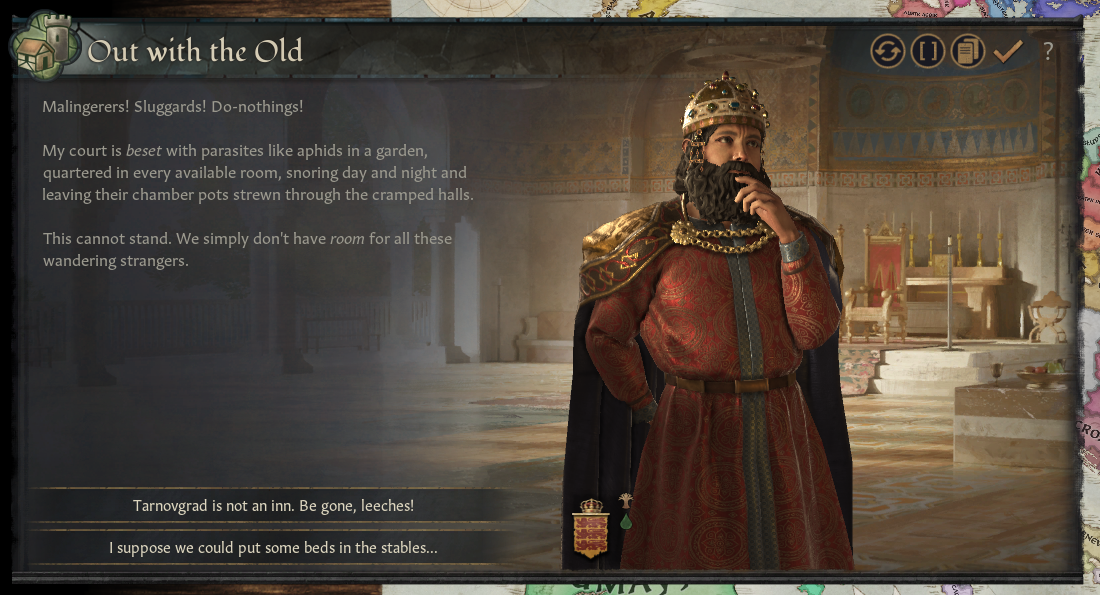
[order mass eviction event]
On the inverse side of things, having so many rooms that you don’t know what to do with them gives a bit of uhhh… space for experimentation.
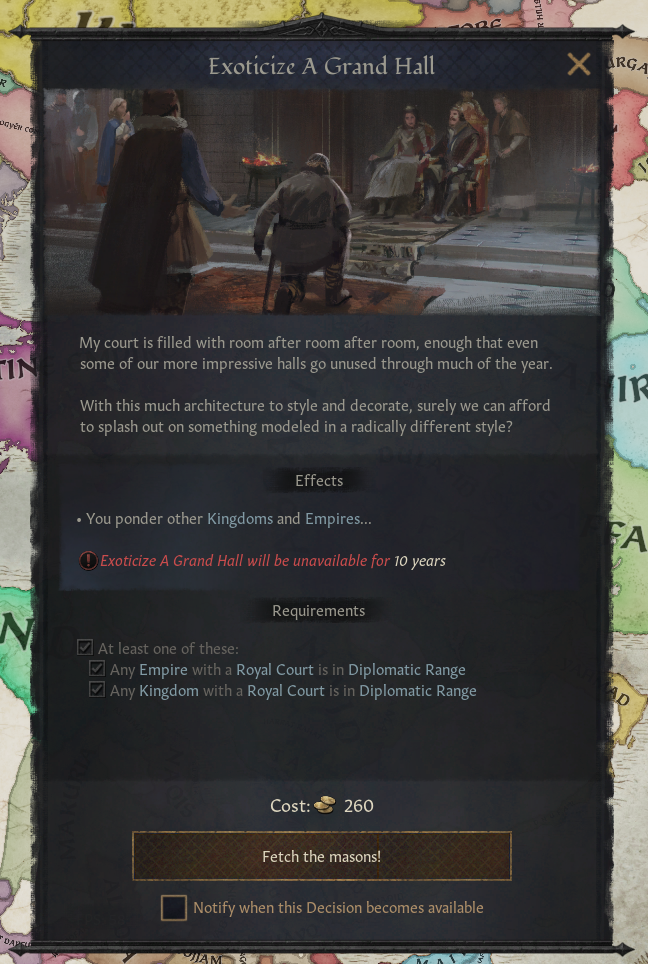
[exoticise a grand hall decision]
Redecorating in the style of a glamorous court is a bit on the nose, but not a bad way to crank up your own court’s grandeur.
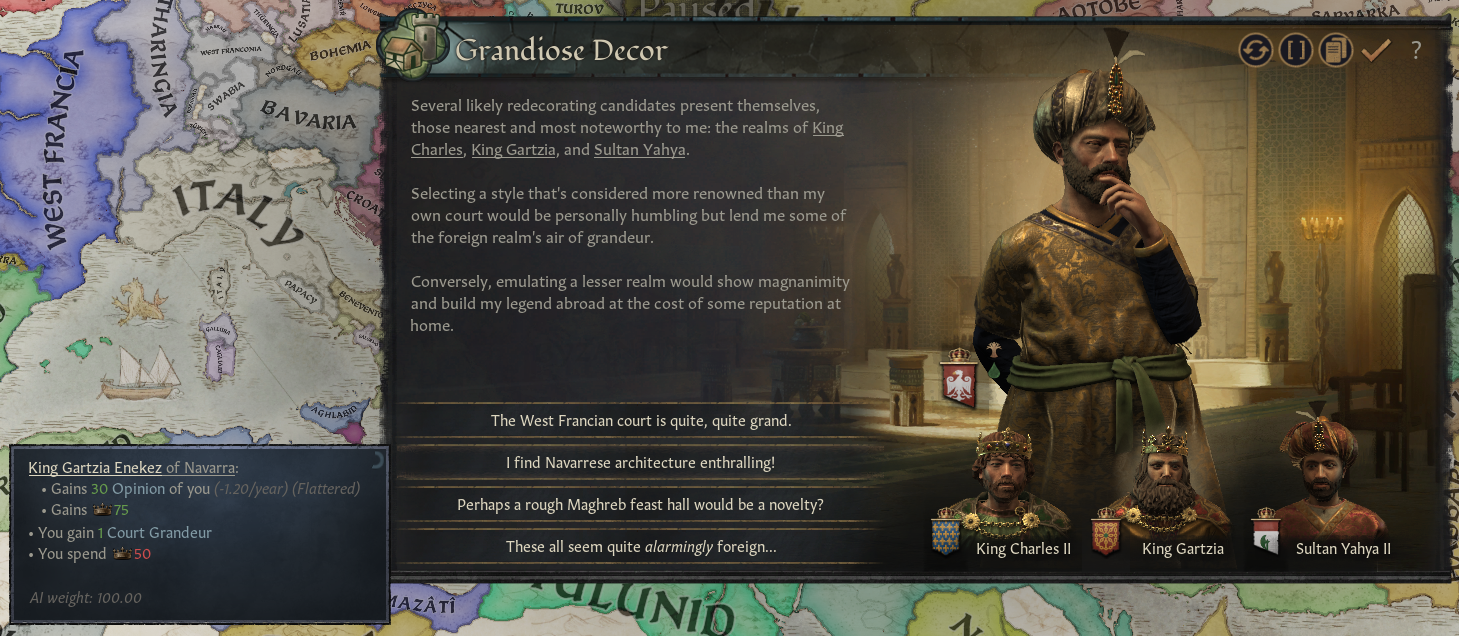
[exoticise a grand hall event]
Of course, for the _rustic_ look, you could redecorate after a less-than-fashionable court...
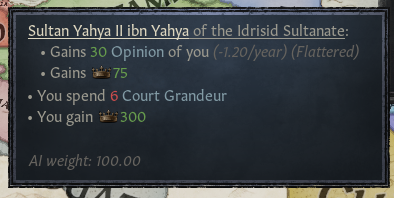
[exoticise a grand hall event, less grand court tooltip]
And, to round off, rulers whose courts lack grandeur that are willing to hold their nose a little can even burn some of their remaining dignity in exchange for skilled staff, rounding out their courts with experience even without pedigree.
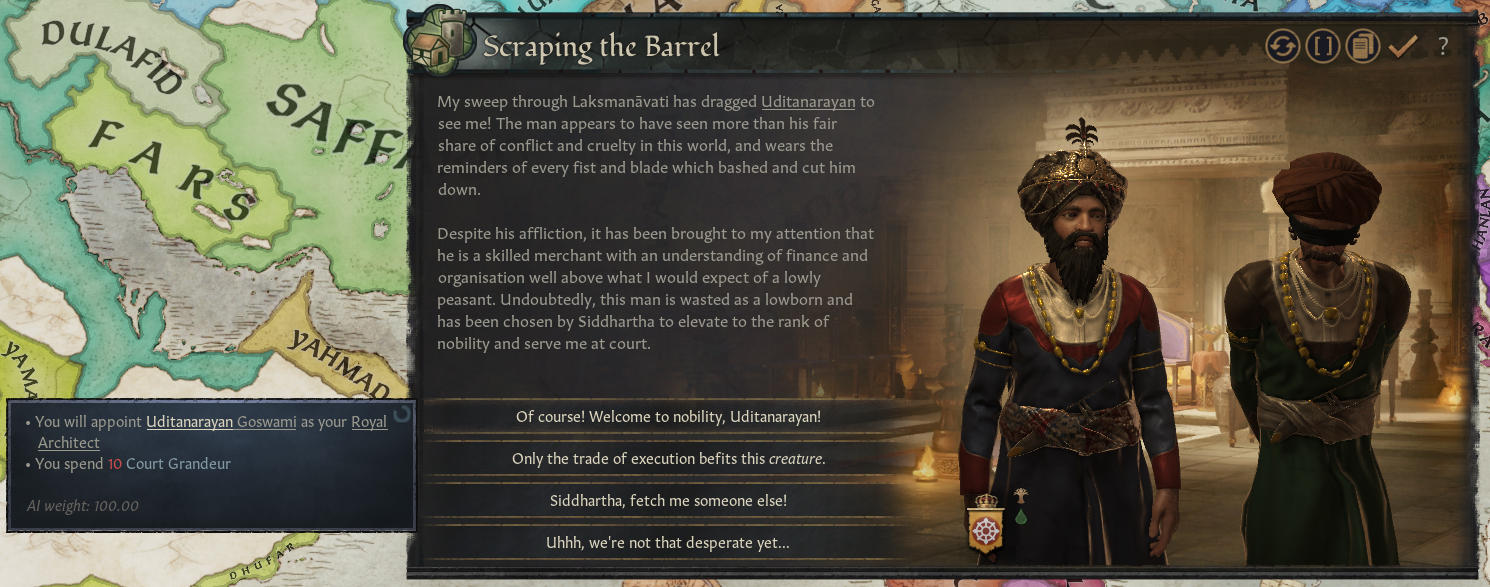
[scraping the barrel event]


This was missing from CK2 too. It was really retarded – often there was a weak, 1-county emperor who could muster like 3k total, which you easily stomp over with your 10k and seize a duchy from his vassal... who had 60k but didn't choose to raise them... yeah...Vassals to arms: only gameplay changing mod I will mention because WHY IS THIS NOT THE DEFAULT AI BEHAVIOR??!?!? Anyway, this mod makes it so that characters that stand to lose land will join their liege as an ally. Characters that stand to gain land get an event, but don't autojoin. I guess this mod could make the game harder, as you won't be invading the HRE without having to deal with a ton of allies helping the Kaiser. It definitely shifts the balance if favor of the defender.
How are the characters who stand to lose land get calculated? When the attacker has claims on certain lands?Anyway, this mod makes it so that characters that stand to lose land will join their liege as an ally.
How are the characters who stand to lose land get calculated? When the attacker has claims on certain lands?Anyway, this mod makes it so that characters that stand to lose land will join their liege as an ally.



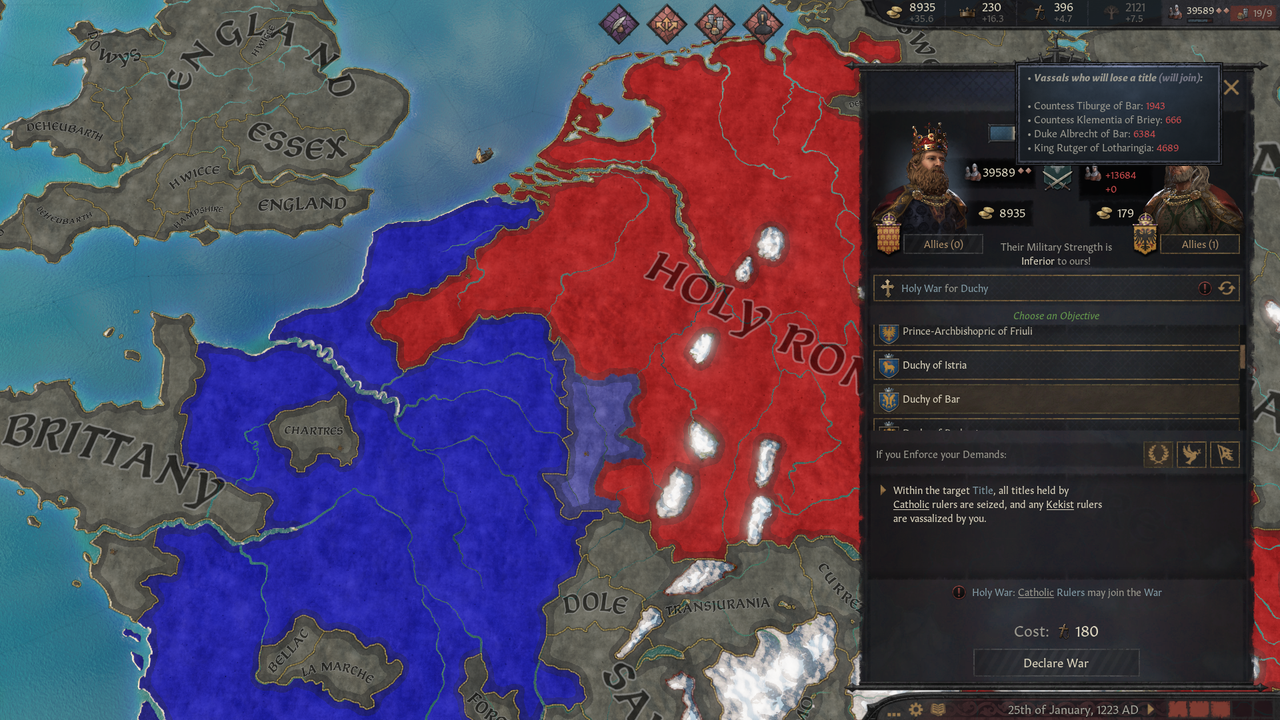


Wow this could change gameplay a lot.
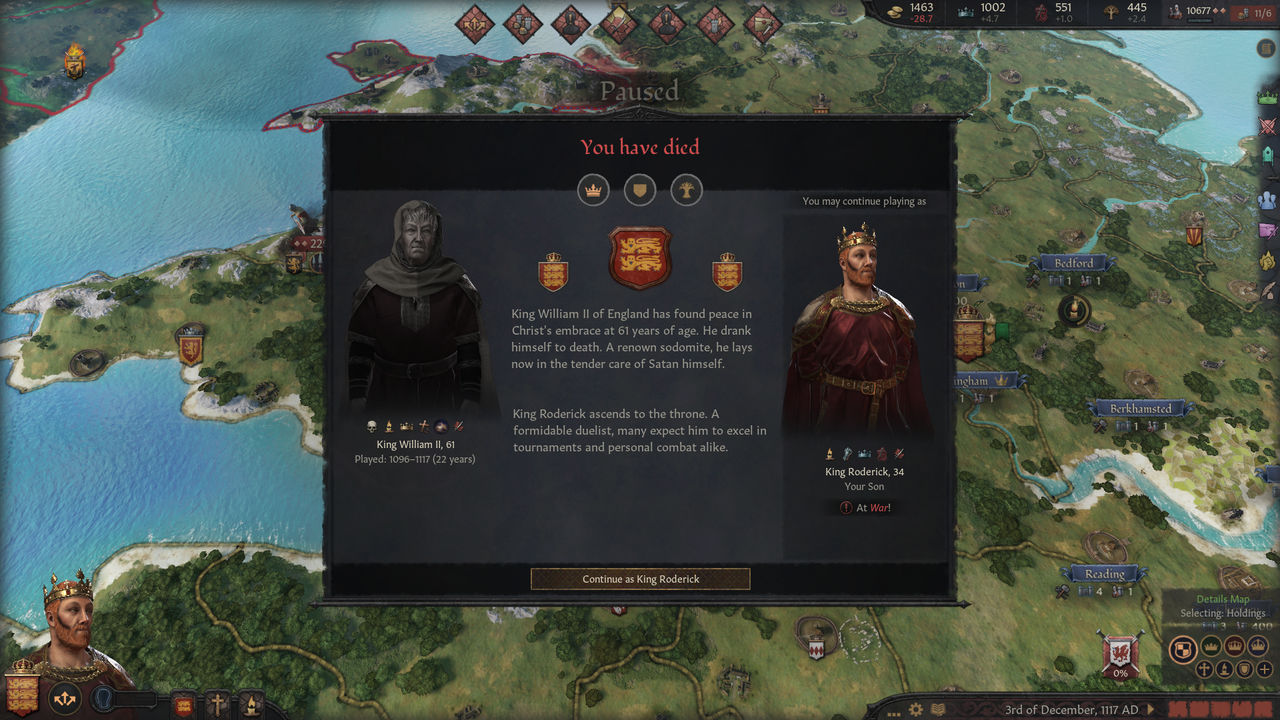




Dev Diary #83 - Adventurers & Royal Court News Inspiration Type "Adventurer", Unique Artifacts and... Royal Court release date!
Hello and welcome to another development diary for Crusader Kings 3: Royal Court!
Today I am here to talk a bit more about one of the more special inspiration types, the Adventurer.
... and also something you might be interested in, at the bottom of the Dev Diary
As mentioned in an earlier development diary inspiration will strike characters at various times and will mean that they have an artifact or a type of artifact that they want to make for someone who is willing to fund their work.
Adventurer
The adventurer is a somewhat unique type of inspiration in that it is much less clear what this person will present to you in the end. Instead this is a character who knows that they want to undertake a journey to explore and look for an interesting thing for you and your court.
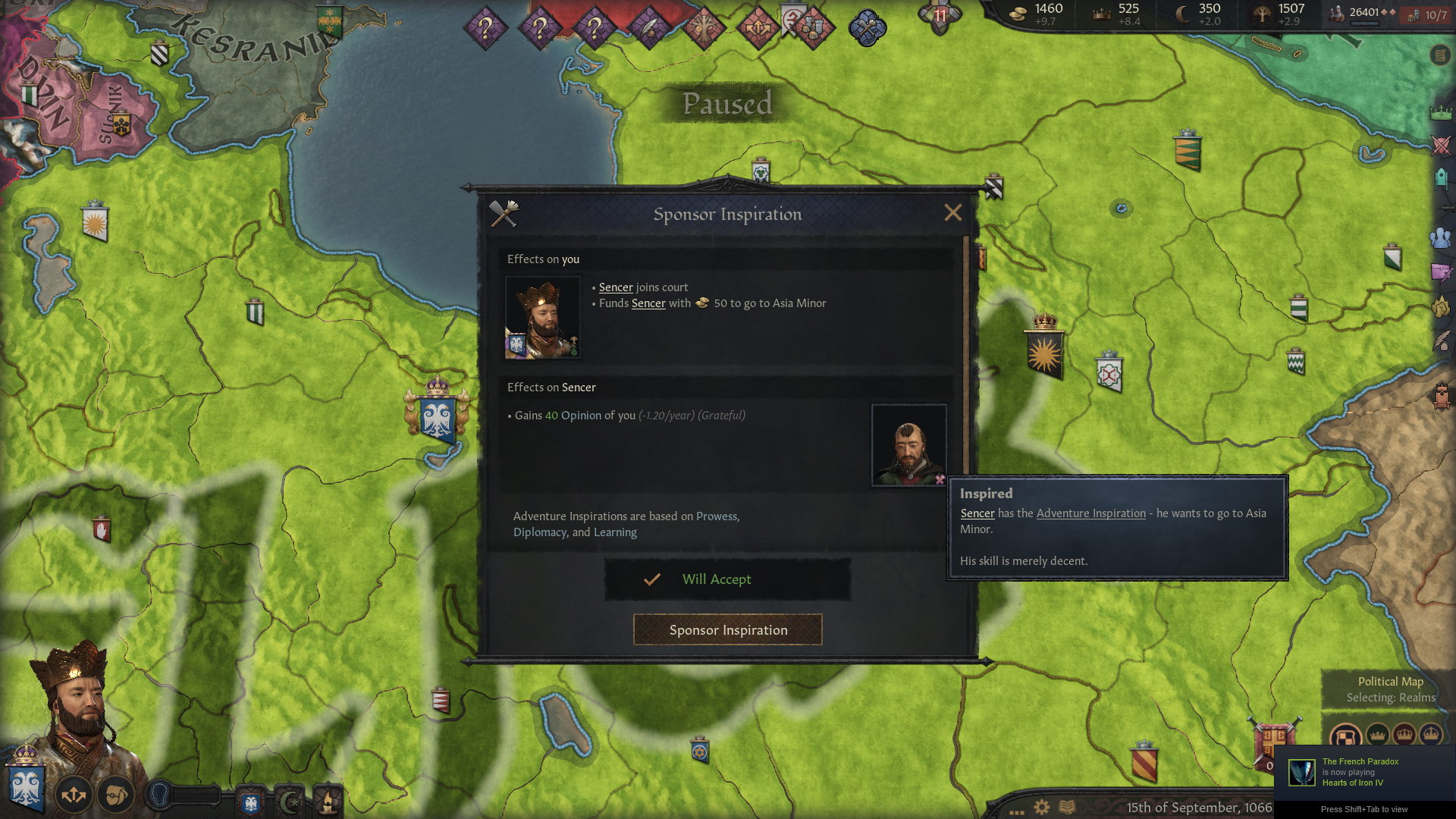
[Screenshot of an inspired person being hired by the player]
How far away a region that an adventurer will want to target with their expedition is mainly dependent on their skill and generally the adventurer already knows where they want to head when they appear to seek your patronage. A highly skilled adventurer might leave the choice of destination up to you.
Regardless of what destination an adventurer will aspire to travel to they will ask you what type of thing they should be looking for. You can let them decide for themselves as their adventure unfolds or you can ask them for a general category of object from the get go (see below).
Depending on the adventurer skill you may even be able to ask them to look for something unique, which will make them actively search for one of the unique historical artifacts that exist in the game. Nothing is entirely certain though, and even an adventurer of low skill might run into something interesting if you tell them to keep an eye open for anything interesting, it is just less likely than asking someone with higher skill to do so.
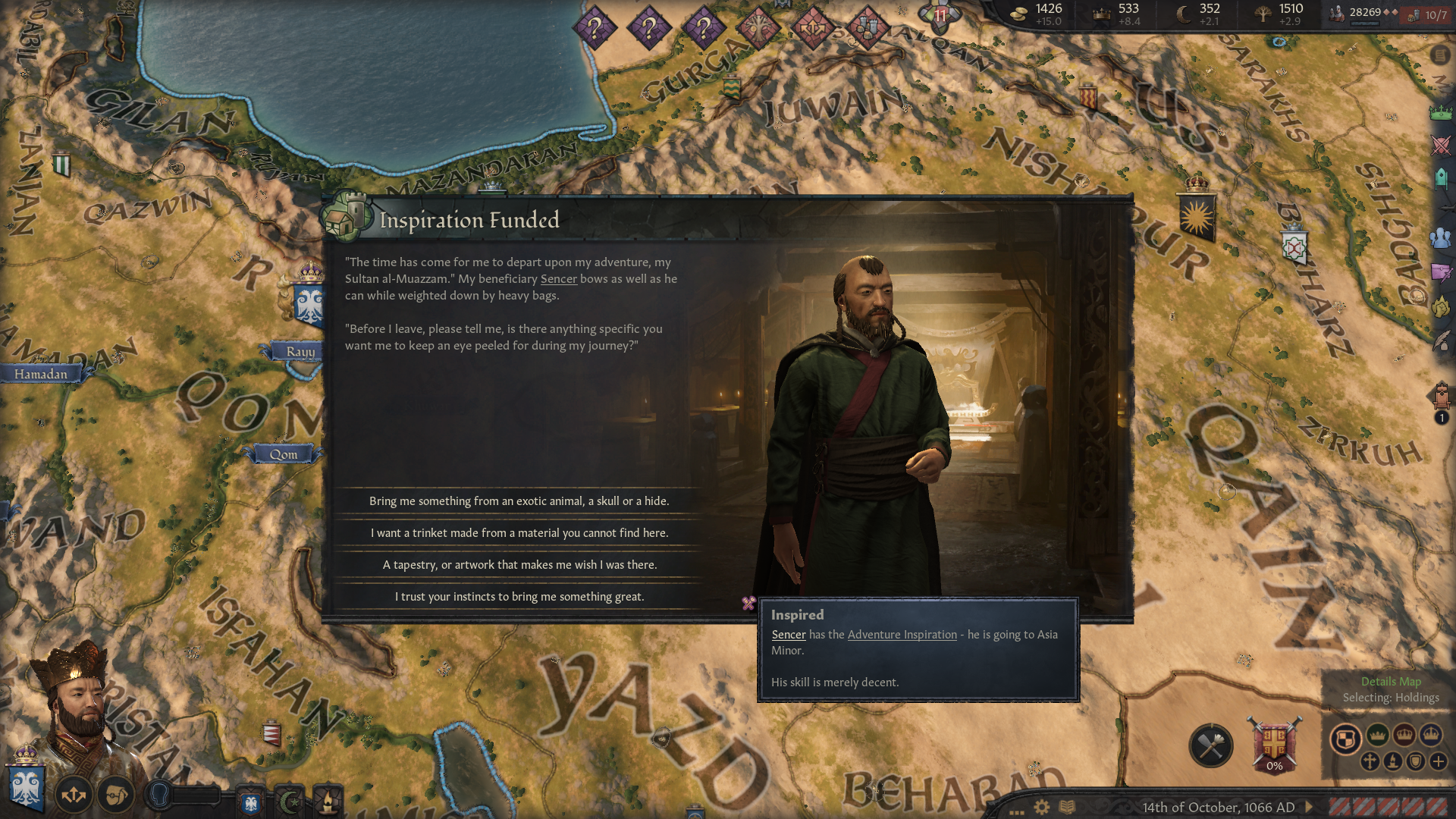
[Screenshot of an inspired person headed for Asia Minor, asking what type of artifact to look out for]
The above are the most common choices, animal trophies, artwork or trinkets are all potential court artifacts that the adventurer can go looking for.
When given free reins you may also end up with a piece of armor, or a weapon from that region (with a visual appearance and local technique to match). There is also a small chance that an adventurer who is told to trust their own instincts could return with something more rare and unique.
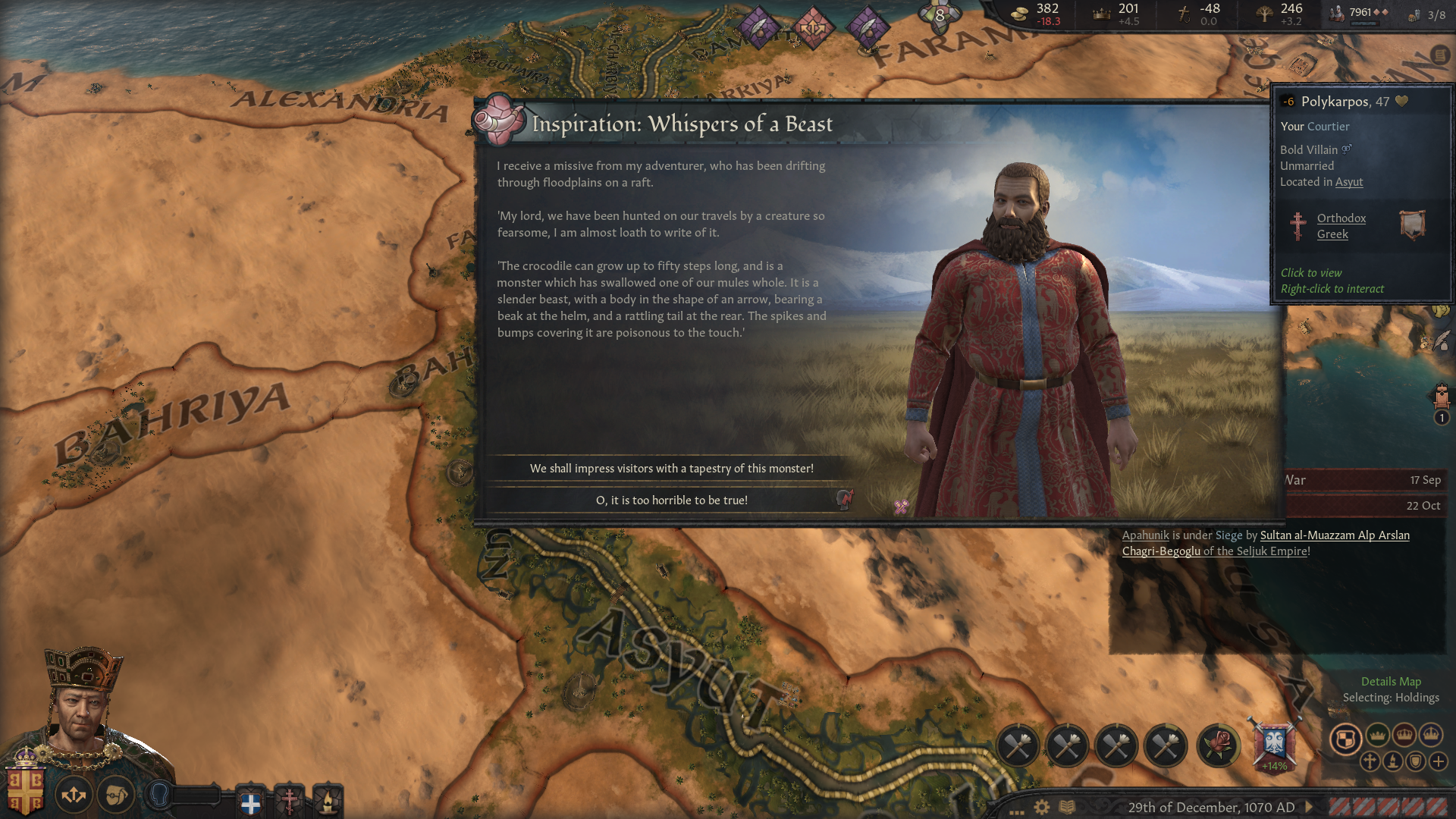
[Screenshot of an adventurer who has run into a crocodile in a county along the Nile]
As an adventurer sets out on a hunt for an artifact to please his employer he or she will send occasional updates to you. Apart from letting you know what happened in the various places the adventurer visited, these events will let you guide them further, potentially impacting the quality of what they bring you home in the end or the length of their journey.
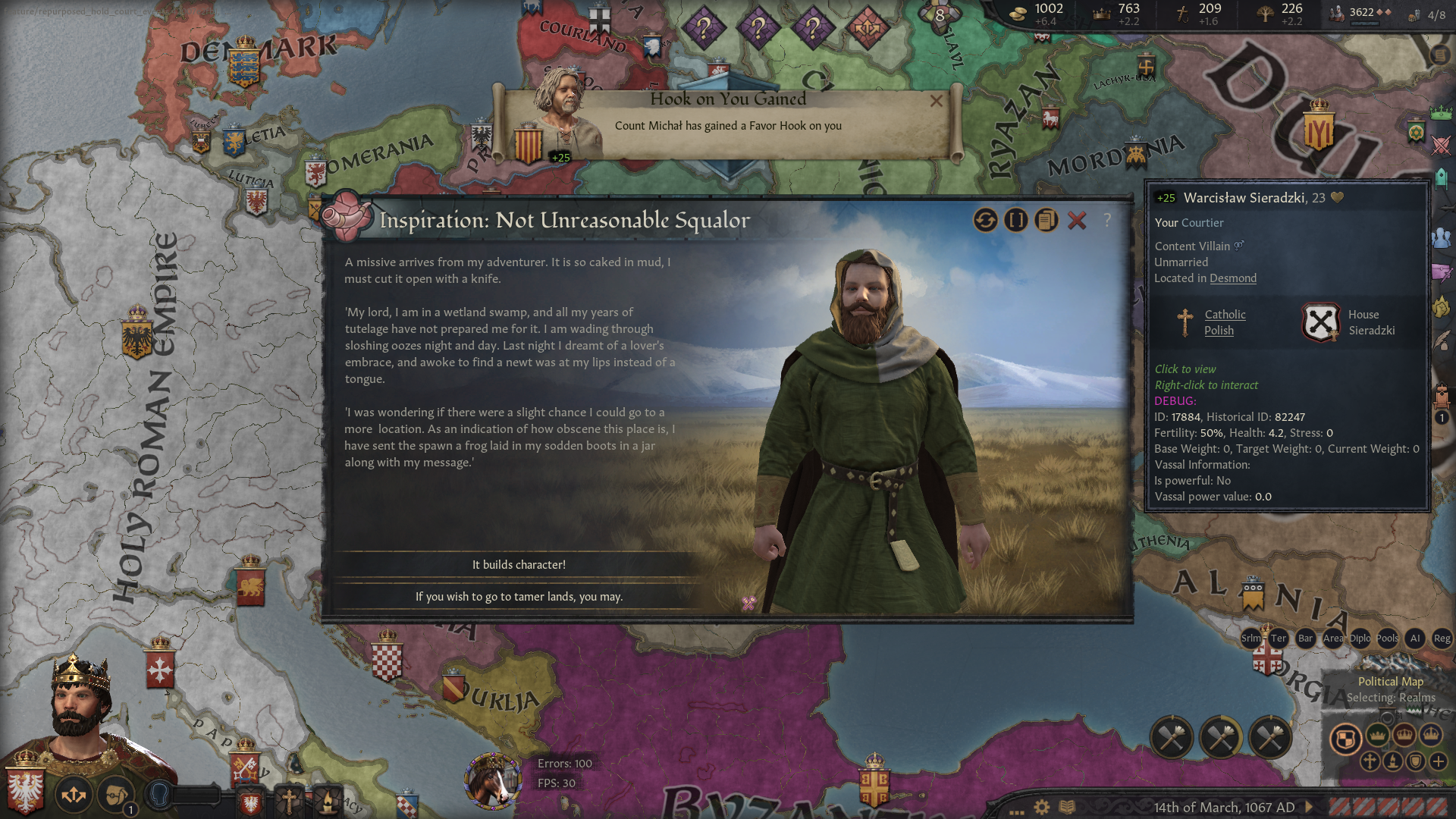
[Screenshot of an adventurer complaining about an Irish marsh]
The adventurer character will move around in the region their expedition has targeted, and events as well as their in-game location will reflect what barony they are currently in.
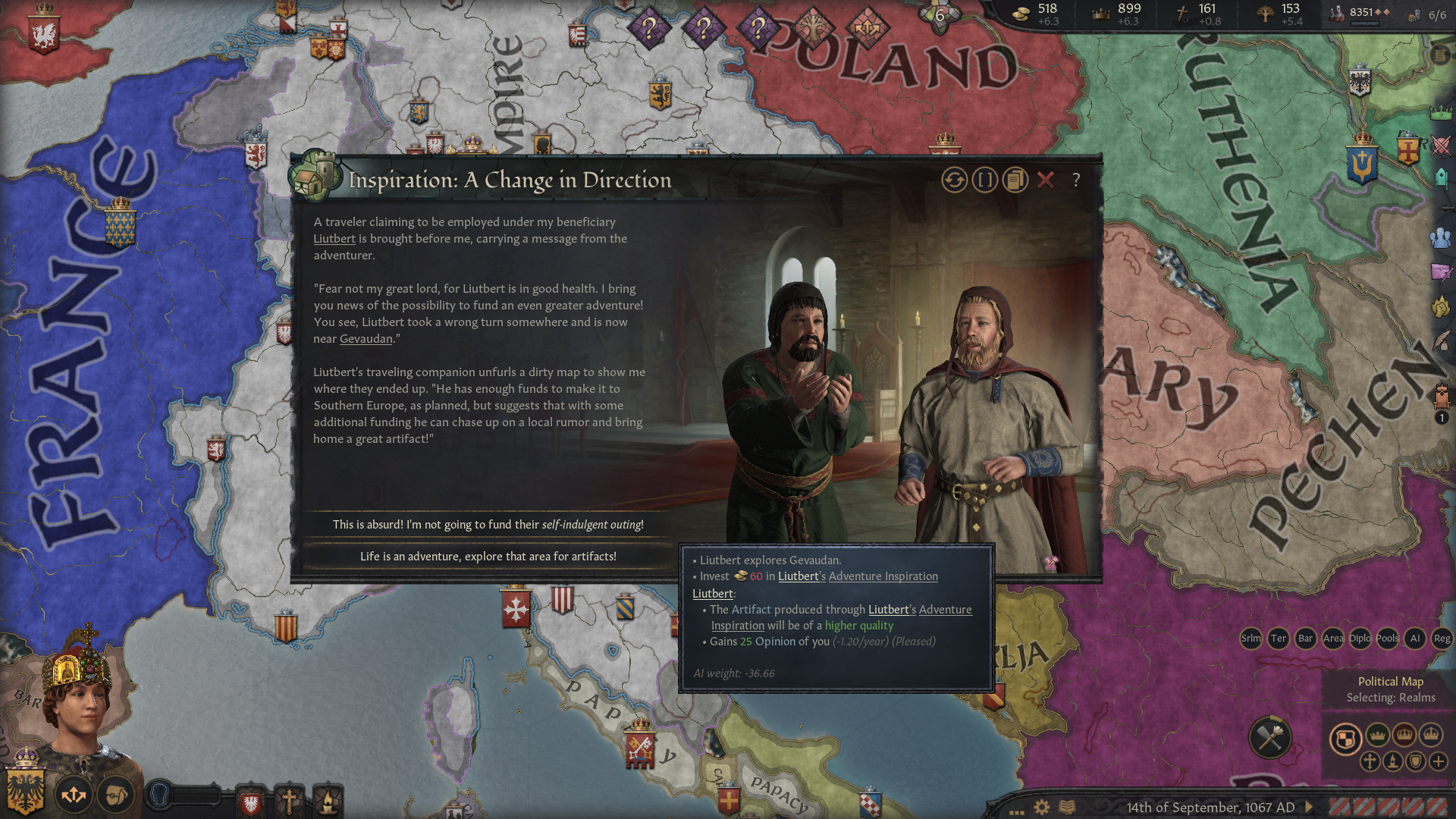
[Screenshot of an adventurer who has gotten lost]
Sometimes things don’t go as expected. Getting lost is not all bad though, as it might mean reaching a region that was otherwise too far away from where they started.
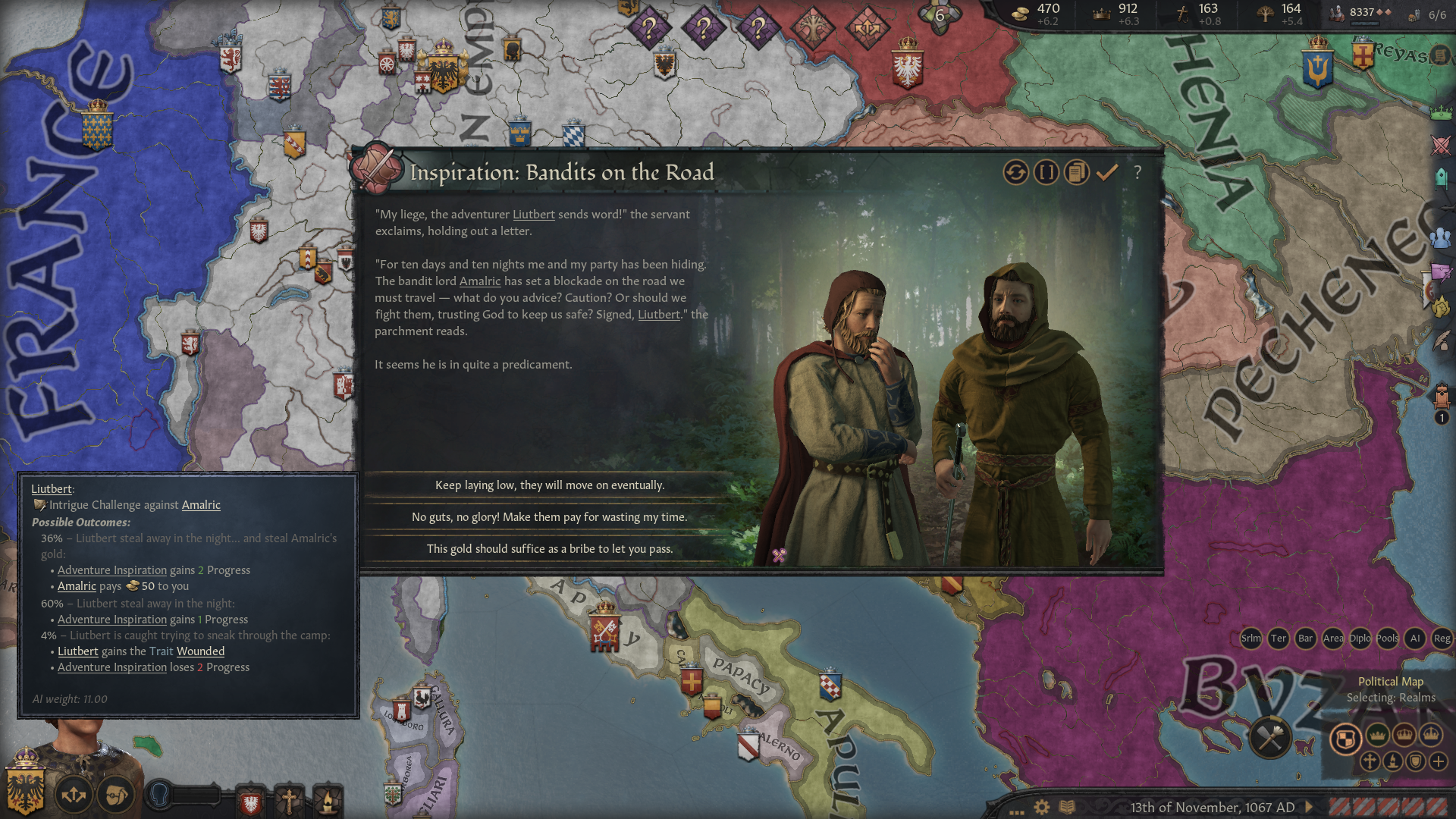
[Screenshot of an adventurer who has run into bandits]
Travelling abroad is always a risk, even for a seasoned adventurer.
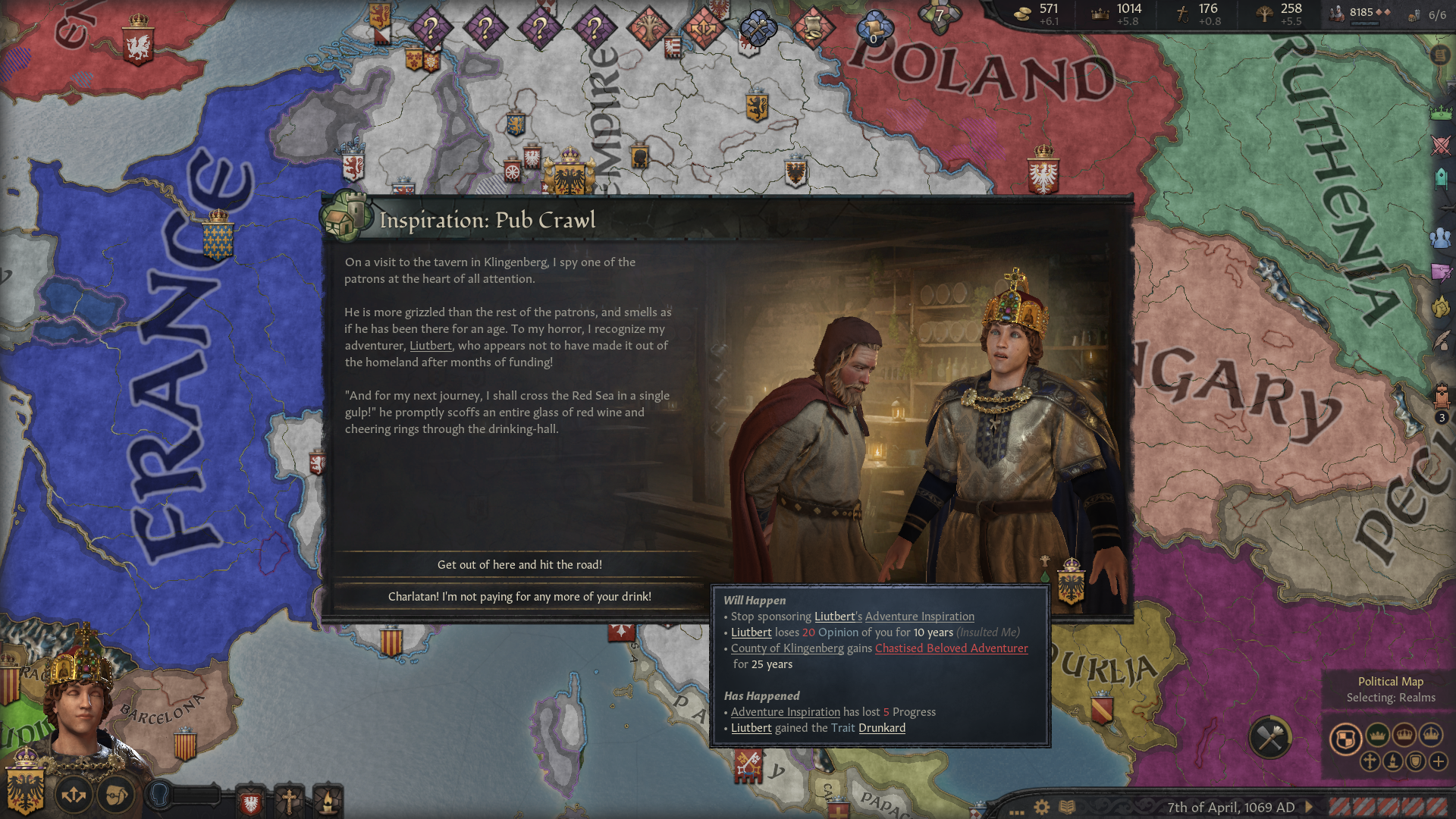
[Screenshot of an adventurer who is discovered as never having left the home town of his employer, instead wasting the money on food and alcohol]
Even the most promising explorers can sometimes turn out to be charlatans (or just be plagued by the stress of the expectations placed upon them).
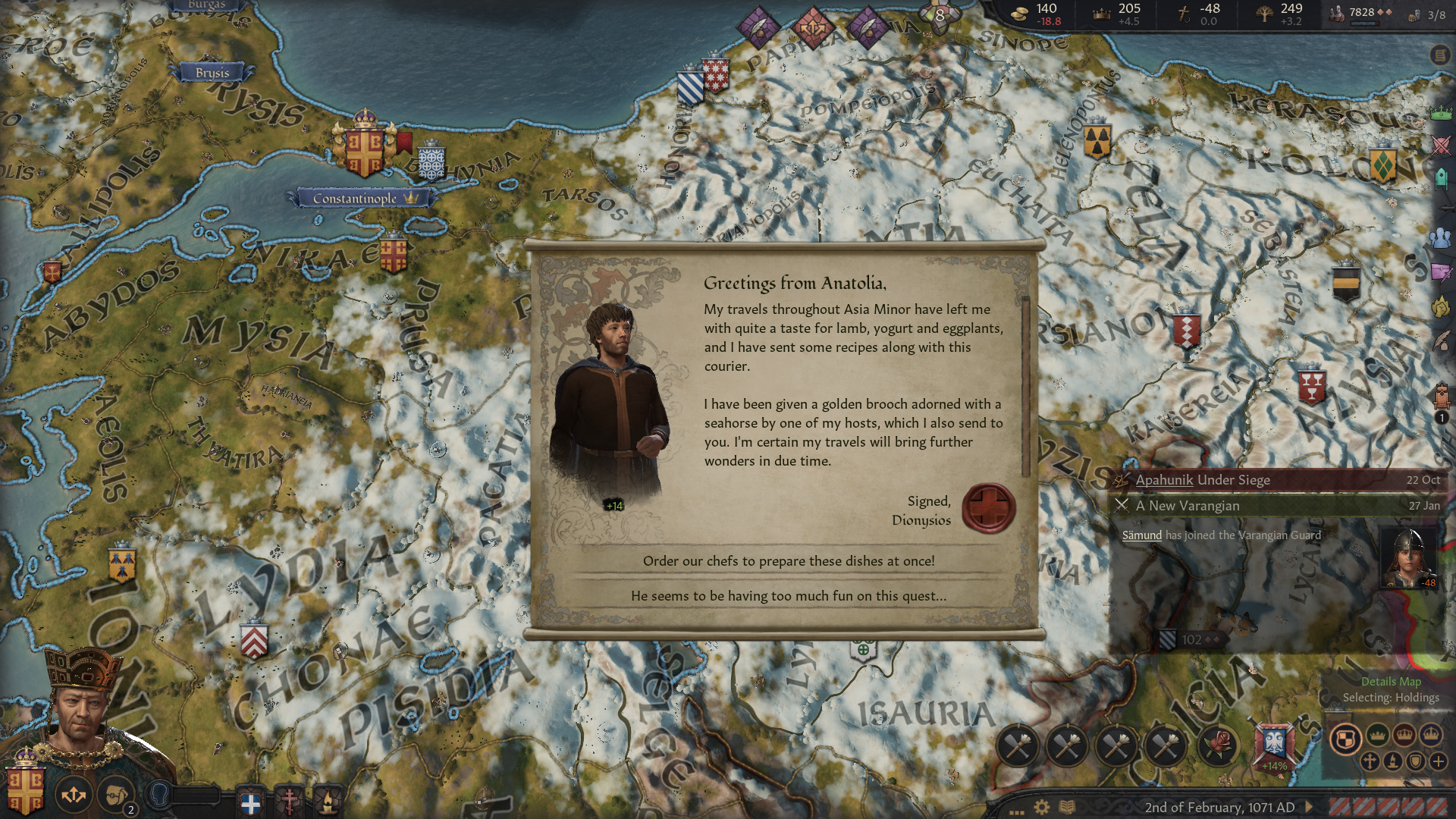
[Screenshot of a letter from an adventurer in Asia Minor]
Some updates are just short letters and the odd trinket.
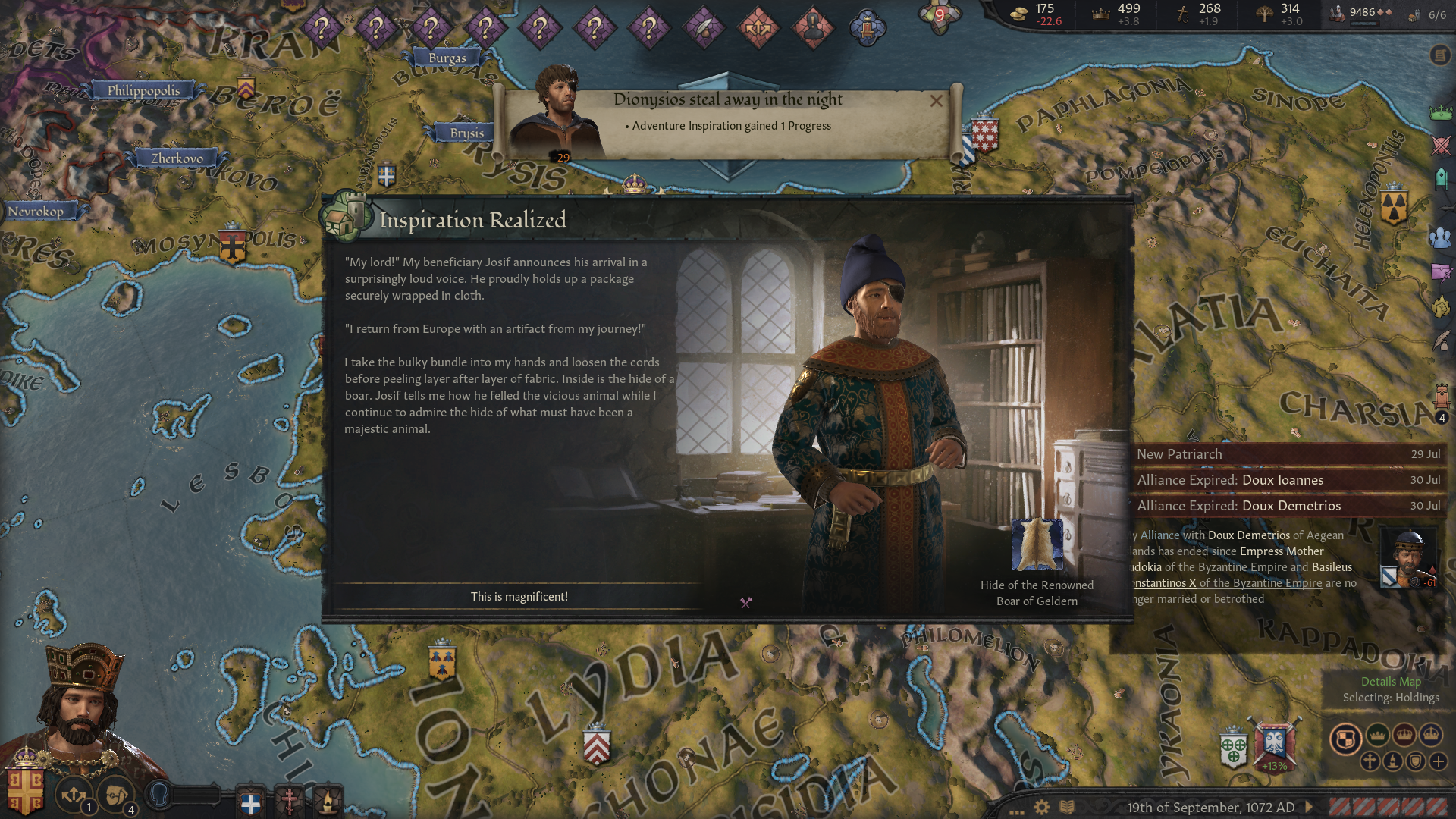
[Screenshot of an adventurer returning from the Netherlands with the hide of a defeated Bear]
Eventually the adventurer will return and present you with their find. Depending on the goal you gave them this might be anything from a trophy made from a rare animal to a unique artifact.
Unique Artifacts
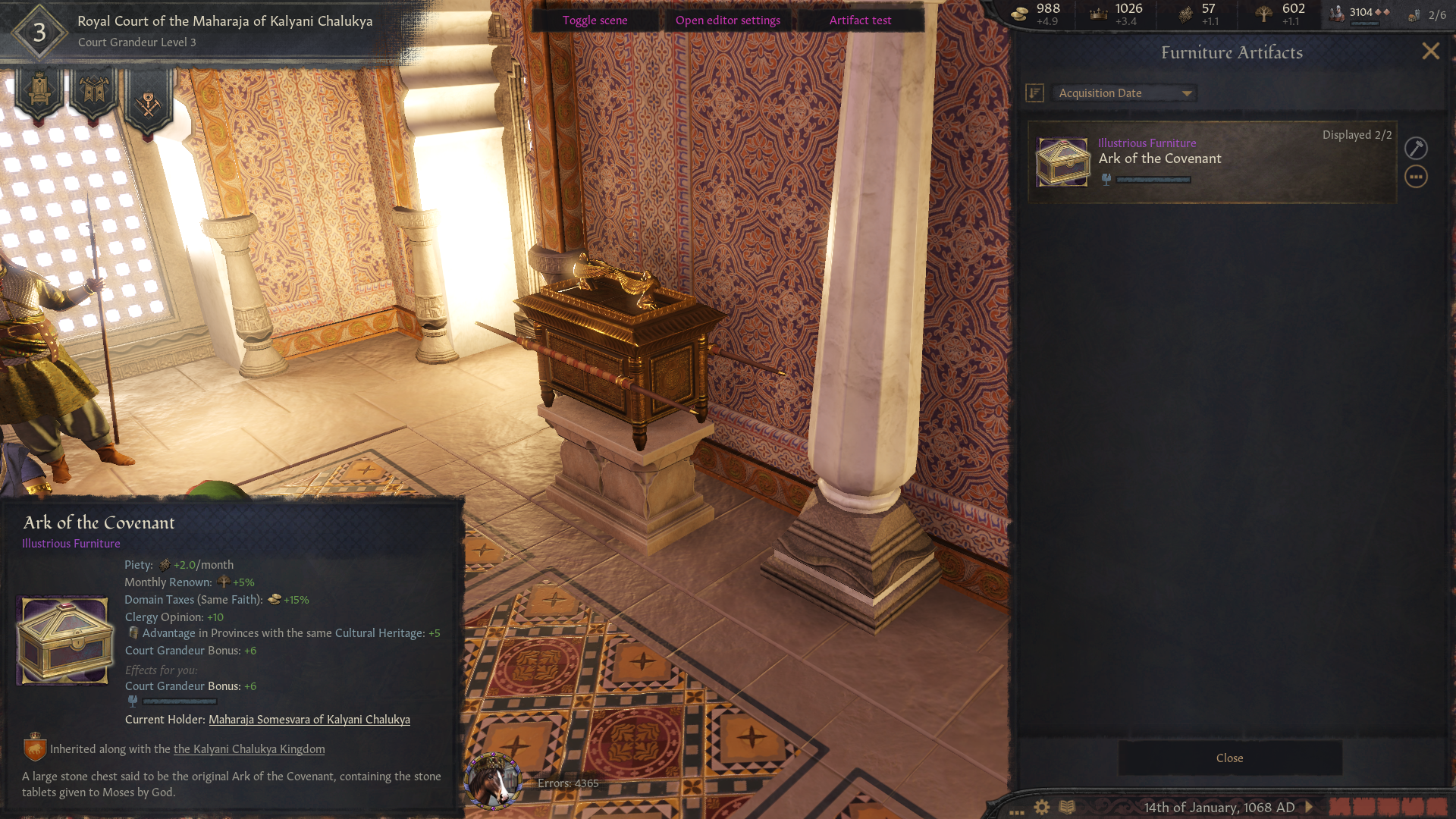
[Screenshot of the ark of the Covenant, resting in an Indian court]
Unique artifacts are rarer things that don’t correspond to any of the existing non-adventurer inspirations. They can be relics like one of the swords of Mohammed (a court artifact to be displayed rather than something to fight your enemies with), they can also be great diamonds, or a weapon or crown once wielded by a known king of the past.
As we mentioned in a previous diary, a unique or historical artifact is not always necessarily what it is claimed to be. As these artifacts are accepted as genuine by your contemporaries they do however make a certain impression on them, reflected in the artifact effects. In terms of rarity a much larger number of these unique artifacts will be rated higher than other artifacts you would run into in the game.
Around 50 such artifacts can come to be found in the game, some of which might also exist in a court at start depending on the start date. Should these be lost at any point adventurers will be eligible to discover them again in their travels. What artifact is found during an adventurer depends on their skill as well as their destination, you won’t find Quernbiter on a journey in India (and also not unless you’ve played past a certain year).
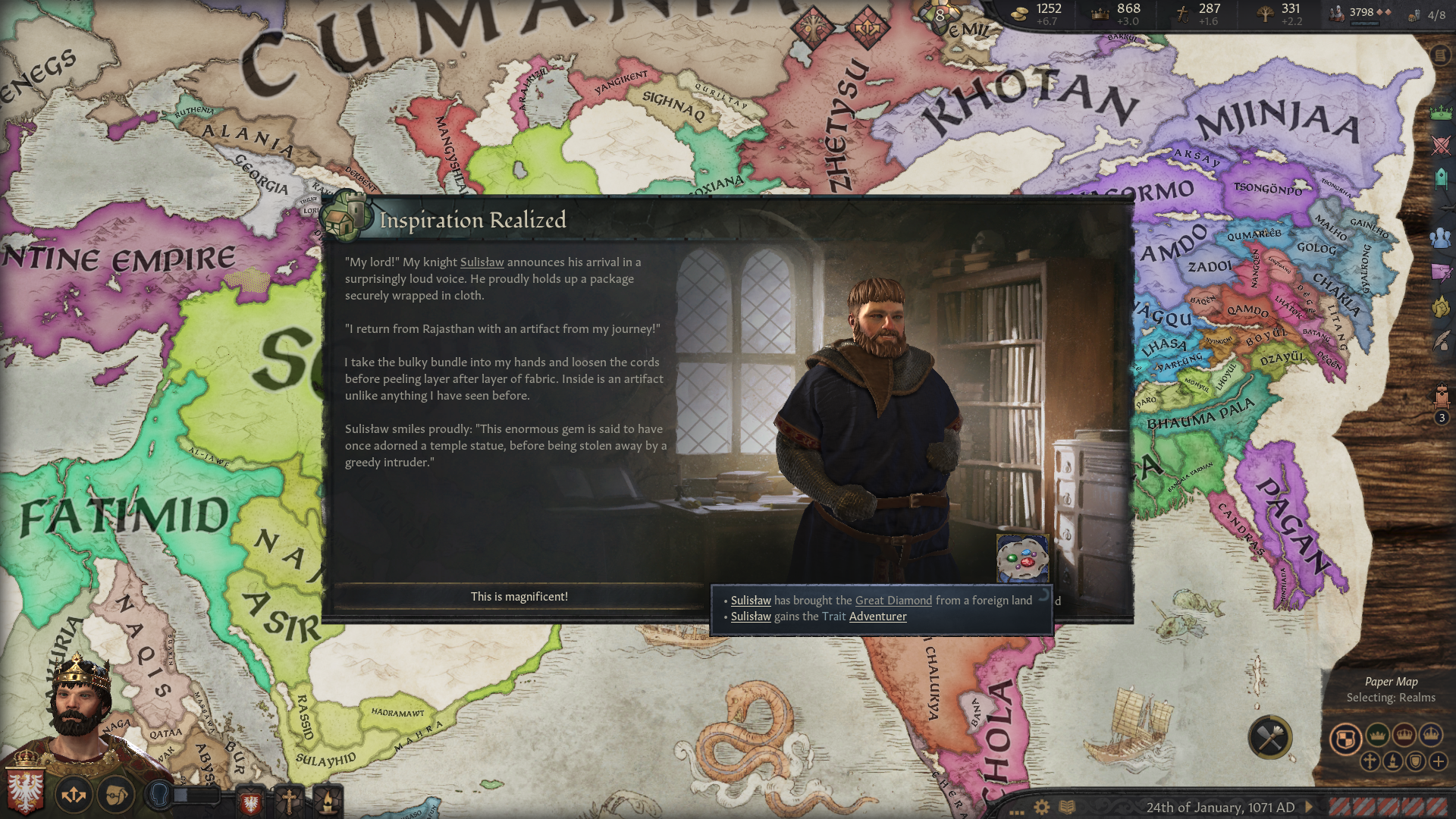
[Screenshot of an adventurer returning with an enormous diamond]
Since adventurer inspirations are relatively more rare than other inspired characters we have also tried to balance the effects of unique artifacts in a way as to make them worthwhile even if they are meant to clearly not be supernatural.
And Now For Something Completely Different!
This year has not been without news of ALL sorts and we do our best to be the first to give you all your Crusader Kings news!
This time is no exception and we are glad to announce without any further ado, that
Royal Court will be released February 8th, 2022
!
This means your throne room will be the center of your kingdom - like it should be.
Become a master of languages, founder of cultures, collector of relics, and more on your own path to become the greatest ruler of all time!
Witness the features you have been expecting and even some you didn’t know you wanted.
Feel free to check out our trailer
CK3 Dev Diary #84 - Building a Court - A Tale of Code and Art.Hello and welcome to Dev Diary #84, I’m @Carlberg , the 3D environment lead artist and today we will be having a closer look at the development of the Royal Court rooms. This is a feature that we’ve been working hard on and it represents a great new step in bringing this historical era to life. Big thanks to @Alien-47 (code), Stella (3D environment art) and Linus (tech art) who's perspectives they've written down for this Dev diary, drawn from their experiences from both code and art in the making of this feature.
Heads up! - A lot of the pictures in this post will be of old prototypes and iterations intermixed later with more recent images towards the end. So no need to worry about issues you may spot in the older images.
A new visual feature
With the new 3D character systems implemented in CK3 we wanted to show the characters of the middle ages in a whole new dynamic way. So as we started laying down the foundations of the Royal Court we also wanted to bring the very courts to life and find continued use for these 3D characters. This new feature was a major step in that direction.
The inspiration for the feature was partly scenes that hearken back to throne rooms seen in games of old where we wish they had been livelier, with more interaction and chances for us to impact the people and objects in them. We drew upon these concepts and ideas of our own to weave together a visualization of the courts hosted by the most prominent royal titles.
The Prototyping
At the beginning of the court development we knew that we were in for a challenge to stake out a new visual workflow within the engine that previously had not had any instances of contained 3D scenes and shared lighting systems within it. So we decided that to start off we needed a working prototype - laying a foundation and gradually adding more and more graphical features and complexity. Moving forward only when we’re sure the previous step succeeded.
A natural starting point of exploration were the characters. We could already show beautiful animated portraits and the courtroom had to be able to show the same people so players could easily recognize their appearance. Could we reuse the same system that assembles characters - show appropriate body, apply transformation to show age, height, weight, apply the same clothing, hair, set the same animation? First step - success. The people in the courtroom look exactly the same as in portraits.
Next step, is it possible to show many people at the same time in the same scene? This is quite different from portraits in the interface and events - those always have 1 person per image, even if the UI tries to combine them nicely together. With some optimization the room could now handle about 20 random characters, and even some objects. So the scene finally resembles a courtroom. Although a bit dark.

The scene could now show several people and items in the prototype
But what can we do with lights? The ambition for the court scene and requirement for lighting is much higher and more advanced than for regular portraits. We needed more simultaneous light sources. At the same time shadows naturally become much more complicated as well. People and objects can interfere with lights and it needs to be visible. Another issue was making sure characters and objects apply the lighting and shadows in the same way, so it’s easier for artists to manipulate the scene and develop the assets. After a bit of time and several iterations we had upgraded and made many improvements to the lighting system.

Lights and shadows in a shared scene — Proof that multiple lights work and blend as intended, if a bit rough still.
It was roughly at this time we felt we had confidence that the goal was within reach, and all technology was working as we intended. It was also clear that we could afford the desired complexity of the scene from a performance point of view. After all, players should have an enjoyable experience both on the map and in the court. We had built an understanding of how many people the scene could handle efficiently, how many light sources, and how many shadows we could allow (this is one of the most expensive parts).
And so the prototype has been integrated as a proper feature of the game.

Scene with better lighting, assets, materials, people positions
From this point on work on the court room continued with multiple people from different disciplines working very closely together. More and more features waited to be implemented, so you can now see the beautiful results of all this effort.
Concept art and vision
Being worked alongside the prototype was the vision we had for the Royal Court-rooms. We began by looking at the four main cultural areas we would be covering in the expansion. The west European, Mediterranean, Middle-eastern and Indian courts. We wanted each of these areas to be distinct, having their own visual style through architecture and lighting so to give their own unique feeling.




Concepts of the different walls aesthetics of the courts, Mediterranean, Western, Middle-East/North Africa and India.
The west European court draws much of its inspiration from courtly interiors of England, Germany, France and neighboring areas. Darker rooms lit by fiery hearths, candles and chandeliers. In the Mediterranean more inspiration comes from the Byzantine courts and those found in Italy and other heirs of Rome. The rooms hint back at this grander past with larger roofs, domes and columns supporting the walls and arches.
In the Middle-eastern courts we have a wider spread geographically, as these courts draw inspiration and cues from the courts all the way from Arabia to the architecture of Andalusia. In India we encountered an interesting split, as influences in architecture were pushing in from the west while there were still distinctly Indian courts. This was one of the reasons behind adding more court variants so that we could cover more of these visual flairs.



Style variation exploration, more on those further down in the Dev Diary.
Each scene was broken down into components like walls, roofs, floors and key assets like thrones, chandeliers and fireplaces. While these were being designed from a plethora of references gathered from each culture we also created variants in the concepts. This was done both as exploration but also to add variance to the courts so that they don't all look the same all the time. You will most likely have seen some variants of these when we’ve shared screenshots in past dev-diaries.

Different courts, different architectural styles, different lighting setups.
But the concept art phase did not end after the initial stages however, because once the scenes were being put together we returned to the concepts to try out the different lighting setups to help in the lighting of the rooms, giving our artists more ideas of where to focus the light and accentuate the scene further. Since the lighting system was being built alongside this in the prototype, the concept art took inspiration from contemporary game engines to help guide the prototyping, and not just the visual development.
A room takes shape
When starting the modeling of the actual assets for the throne rooms there were several constraints to keep in mind. We had decided to go with a modular workflow so we could easily swap out wall-types and materials, so the dimensions would have to be consistent and work with the plans and concepts we had decided to pursue. We were also making several visual variants for each culture, which meant that we had to try and keep the details of the walls and materials equally interesting for each different type.
Another big limitation was the fact that we had never before made a scene within our engine like this, so that meant that there were a lot of uncertainties when it came to how much we could push the graphics and where the limits were. Since we were also going to have the artifact system we had to make sure we left enough room for the artifacts and banners without having the environment taking too much attention. This became a trial and error phase to find a good baseline for each throne room.

Early blocking out of the different artifact and furniture slots to be able to see where in the environments we had to make space.
To create variation we made sure to have the materials contrast with each other while still fitting together aesthetically so no culture would have throne rooms that all felt exactly the same. This along with changing some architectonic aspects helped the scenes be more distinct. We also worked on adding variation to the the grandeur levels, here we wanted the difference to show in the cleanliness and brightness of the environment textures, as well as in the richness of detail in the geometry and amount of decorative props. (Visual examples of this are shown in the final chapter)


Making sure the different materials work together to create a cohesive feeling for each culture, but still looking different from each other. Example images taken from the MENA culture throne rooms.
Lighting and FX
A lot of our visual tech usually involves considerations for a top-down map, and since we didn’t have much need for full scale 3D room rendering & lighting in the past, we had to do a lot of rethinking to get this to work - we went from previously having 4 lights, moving up to 20 total light sources and expanding the light types available with new ones like area lights - adding sphere & disc area lights. This helps illuminate areas such as room filling bouncing light (seen to great effect in Mediterranean courts) and helps us with light coming in from the windows and other openings.

A cozily lit interior.
Another technique we used was animated lights. They move a little, flicker in intensity - very useful for making the fireplace feel like it’s actually on fire and heating up the room a bit. To sell the atmospheric feeling in the room, we added some transparent particles with a little light fade on the sides of the windows and other select places. Even though it isn’t adding to the “real” light of the room, it helps give it that last piece of convincing magic touch. We also used particle systems for effects like the fireplace, candles and torches.
The concept art helped us find the vision of what we wanted to do. Starting with just the room geometries, we used the color hues and general light level from the concepts to create a lit space that felt cohesive, which we then could tweak and modify until they felt comfortable to look at.
Technical hurdles & Bloopers
One of the hurdles throughout the development of the court scene were tools - a means for developers to manipulate the scene contents more efficiently - edit objects, characters, lights, change their positions, add or remove to have a toolset that allows more quick iteration and direct interaction. It took time to develop a solution that made this part of work less tiresome. One of the downsides of not having readily available tools - you have to do those yourself, and sometimes reinvent a wheel multiple times. But we’re lucky to have an internal tools team that came to rescue us, and it improved the processes immensely.
We had plenty of funny bugs over the court of development, resolved by now of course.

It's not a cult! — Sometimes visual bugs can be quite fun

Baby Bighead bug.

They say you shouldn't lose your head in court, but this is ridiculous
Finished courts and courtly variation
With a working feature, concepts drawn and all the parts built we got to compositing together the scenes. There were a lot of iterative steps working on the textures, lighting and positioning to get all pieces to look their best. The environment team has made a set of three different variations of each cultural court type that each has their own architectural and/or decorative flair and visuals, the scenes differ more in geometry and configuration or the construction materials used. So there may be more windows and ample light, or a fireplace castings its warm light into your court.



The western European inspired courts, with stone and plastered walls.



The Mediterranean courts, drawing inspiration from the Roman past as well as the melding of surrounding cultures.



The Middle Eastern courts, drawn on from architecture found in Arabia to Al-Andalus.



The courts of India, greatly varying interiors.
Grandeur variants was a further change we added later in the development cycle, which helps give a little extra flavor to the progress of your court's grandeur. Lower court grandeur has less fancy details and furniture extras in the court than the higher level which sports more of them. The surfaces of the room have also been made to look more worn and less taken care of at a lower grandeur level, compared to the high grandeur which look their grandest.

The Pomeranian kings court has seen better days, its painted plastered walls worn and peeling, the floor tiling tired, scraped and just slightly dirty.
Little decorations or extra furniture have been afforded the kings halls.

After much investment in upping the level of grandeur, the court's floors are fresh and polished, extra candles and seats added to the court, and a long finely woven rug lines the path up to the throne.
Wrapping up
And with that we’ve come the full way from inception all the way to the finished scenes. We’ve been continuously tweaking and polishing stuff like camera angles, lighting and textures, and we do hope this is a great foundation for a feature that we can grow over time.
So a big thanks from the court and environment team for checking into this Dev Diary, which will be the last one of the year, but fret not! We will still be bringing you weekly teasers all the way through December to the start of next year.
These teasers will be smaller in scale and focus on some minor features and things we still want to show off, so keep your eyes out for it next week.
What's a scam about CK2? The obscene pricing on all the required add-ons needed to make it not shite? Paying for things is for suckers, mang.Sooo... CK2 is a scam, is this actually a complete and enjoyable game out of the box?
To be fair, that 60K is composed entirely of levy trash and the only thing that will happen if he deploys it is that he will lose even faster due to them being turned into free warscore as he feeds them piecemeal into the meat grinder. when you can obliterate 200K Chinese deathballs with 5K and wipe out half a million crusaders, you just don't care about 60K of pissant garbage levies.This was missing from CK2 too. It was really retarded – often there was a weak, 1-county emperor who could muster like 3k total, which you easily stomp over with your 10k and seize a duchy from his vassal... who had 60k but didn't choose to raise them... yeah...
CK3 Winter Teaser #1 - Photo mode
Salutations, I am Carlberg, the 3D environment art lead on CK3 and today we have a small teaser for that button you may have spotted down in the right corner on a lot of dev diaries. It is the button that will bring up the Photomode of the court, to make it easier to take memorable pictures of the events and happenings of your court! Along with this preview we also thought we’d show off some more artifacts in their natural habitat.
We’ve been confident for quite some time that our players would want to take some pictures of what happens in their court, the interesting courtiers interacting or from finally seeing your rival and vassal arrive to bend the knee. So for that purpose the Photo mode will give everyone the ability to pick what camera is currently active out of a curated selection. Some of these are camera angles that you’ve seen depending on different interfaces and some camera angles only available in the photo mode.








